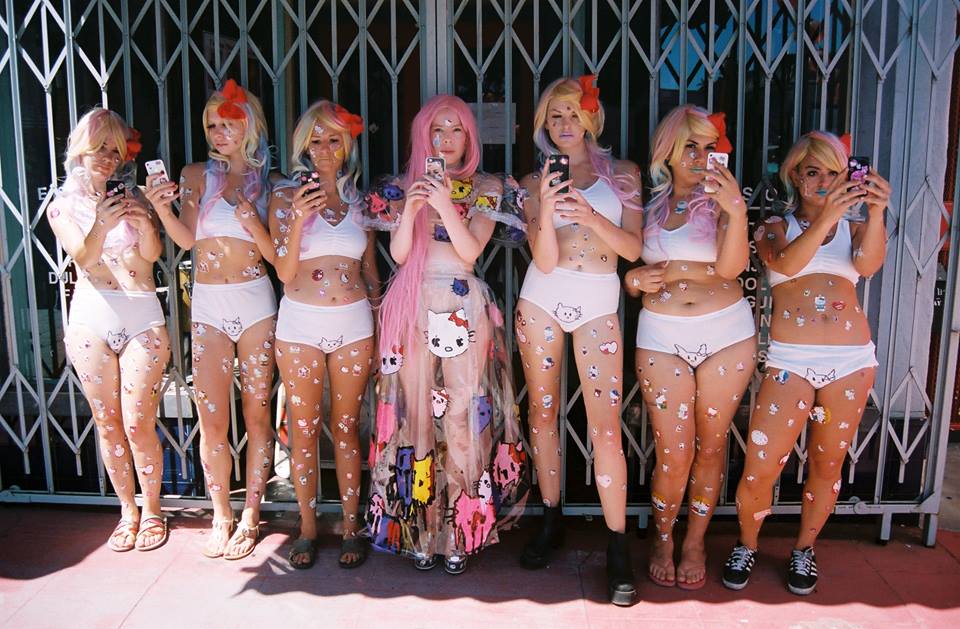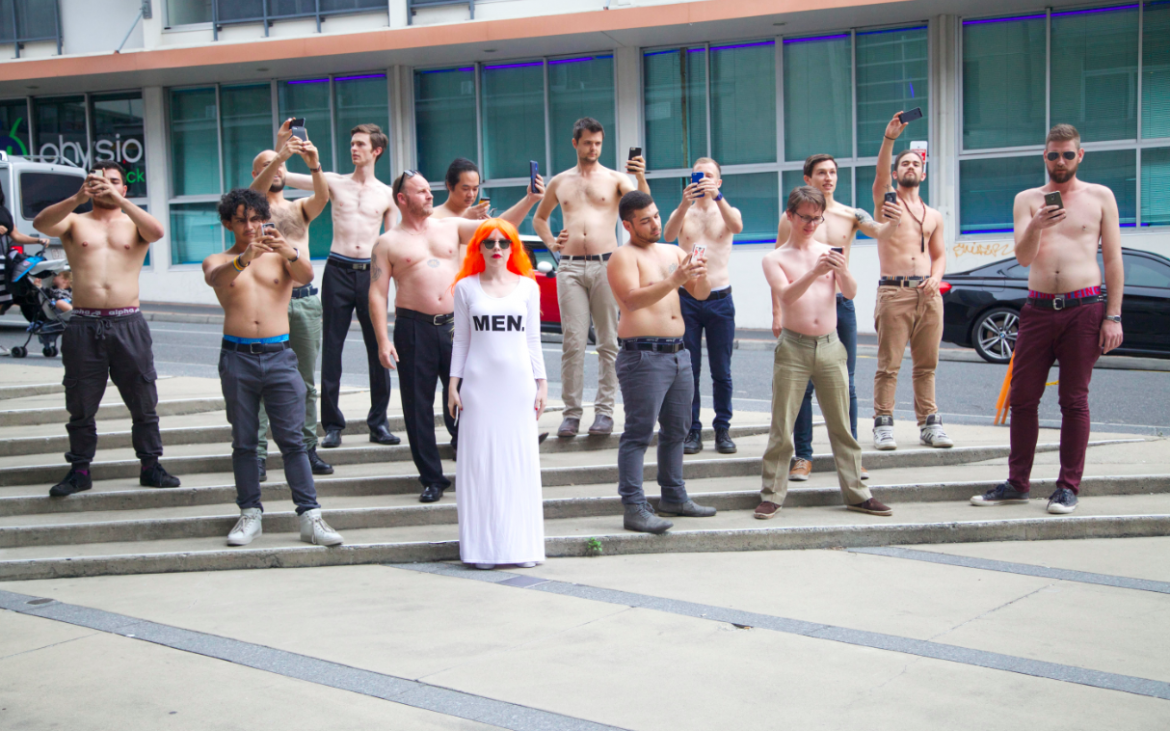Hello, Selfie! Kate Durbin on Selfie Culture and the Girl Gaze

Image: Hello, Selfie! by Jessie Askinazi
Kate Durbin is a Los Angeles-based performance artist, conceptual artist, and writer. She is the author of multiple books including E! Entertainment, The Ravenous Audience, and ABRA, one of the founding editors of the technological journal Gaga Stimata, curator of the Tumblr-based project Women as Objects, artist of the feminist performance piece Hello, Selfie!, and has many more leading roles in feminist projects. Her experience with a large variety of mediums has allowed her to become an engaging voice on important cultural phenomena such as the selfie, reality TV, and the female identity. By exploring contemporary and popular culture, she has become an icon within the art world. We were lucky enough to conduct an interview with Kate in which we discussed the meaning behind her past works, the girl gaze and the importance of feminist art as a whole.
Durbin has shown an interest in the expression of the “teenage girl identity” in pieces such as her Tumblr project Women as Objects.
“I was really fascinated by a variety of things that girls were doing in the space, and I felt like because it was teenage girls primarily who were creating that aesthetic and playing with that aesthetic, that the dominant culture would not, and did not, take interest other than to maybe steal from it or mock it. I wanted to archive it, I wanted to preserve it and I also think there’s a lot we can learn from laying things side by side and the process of accumulation…another thing I loved about Tumblr and [why I] thought it was so interesting [is] because in viewing the [Tumblr stream], you can actually kind of watch culture forming in front of your very eyes because people are taking one thing and reblogging, changing it a little bit, passing it on to the next person, almost like a hot potato or something and that was really interesting to me too, that you could watch that process visually, which is something you normally can’t do.”
This fascination with the female identity continued in Durbin’s passive-aggressive performance art titled Hello, Selfie!. In it, an army of female performers bear white sports bras, underwear, an array of hello kitty stickers, cell phones and girl gazes that epitomize the idea of narcissism itself. The performers take selfies for an hour straight. They are not to interact with the audience in any way other than through the selfies that are uploaded to social media in real time. Although the piece is meant to be left open to interpretation, Durbin addresses the misogyny behind the critique of teen girls’ involvement within selfie culture, saying “I also thought it was ridiculous because girls are objectified from the time they’re very young. They’re taught to be so aware of their appearance and how they look to others and yet, they’re being criticized for looking at themselves and being aware of themselves as objects.”

Through Hello, Selfie!, Durbin also deals with the power behind the girl gaze and its relationship to the male gaze.
“The girl gaze is like a fuck you to the male gaze because she’s looking at herself and she’s aware of the male gaze, but she’s refusing to cater to it, but then there’s also sometimes the thing of the girl gaze as having nothing to do with the male gaze at all. It’s your conversation with yourself and your own image and self love and countering, well not countering, just engaging with you. Why is it that every time a woman looks at herself or just takes a picture or dresses in a feminine way does that have to be a response to men or the male gaze? Can’t it just be because she loves herself or likes herself or what she’s wearing?…It almost seems like our interest with the male gaze is giving it more power than it actually has or needs to have.”
Bringing up the subject of selfie culture alone seems to lead to opinionated analyses. Durbin intended the project to be left open to interpretation, but the results were nevertheless surprising. “A lot of the art world people who saw it thought it was a critique of selfie culture,” Durbin said, “which I thought was interesting because we’re simply, I mean it’s not simple, but we’re taking selfies for an hour straight. We’re not saying anything, so there’s nothing to lend to the interpretation that it’s a critique, but there’s nothing to lend to the interpretation that it’s a celebration either.”
The performance art piece has been performed in Los Angeles, New York and Miami, but in Brisbane, Australia, the piece was modified so that the performers were male.
“What’s interesting is that I went to Australia with men and that piece has gotten—well I don’t know if it has gotten less attention because of, you know, just practical factors being that I was in Australia and I didn’t have as many connections there, so press for the piece wasn’t substantial, but I wonder if part of it was because we’re just not used to seeing selfies from men as much and this whole idea of ‘real men don’t take selfies’ is something that is perpetuated. A lot of men thought they had their own unique perspective on selfies which were that selfies were silly and pointless and frivolous and all these things, but like, these are all culturally indoctrinated ideas that individual men have picked up on and I don’t know, it’s just interesting how that iteration of the piece is as invisible as the male selfie is.”

Recently, Durbin’s work was shown in the gallery exhibition Exquisite Corpse alongside other prominent feminist artists such as Poppy Jackson and Rupi Kaur. Such collectives of feminist art are very important contemporarily because they generate conversations concerning gender-based issues that still occur.
“I think one of the things that feminist art does is get people riled up. Now with the internet, thankfully feminists don’t have to get the approval from institutional powers as much to get their work out there, so I think that’s really good. But at the same time, it’s still a struggle. Women are not well represented in the art world and they’re not given as many resources…I know for me, when I was a younger girl, it was really feminist art that saved my life…It was really feminist art that made me feel like I could keep going and I could be powerful and I could embrace all the aspects of myself that culture had taught me to hate, so I know individually it can be very powerful and radical and important.”
You can follow Kate on Tumblr for updates on her upcoming projects.




